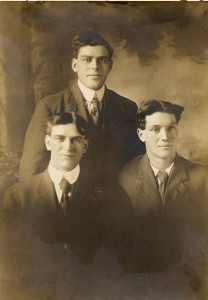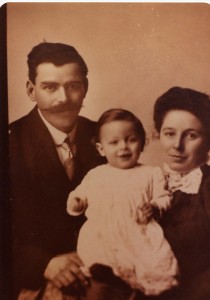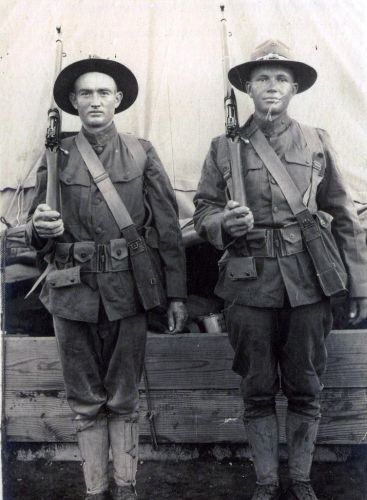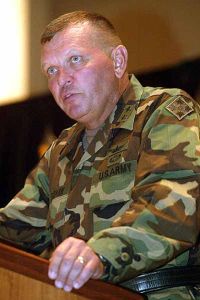Johnson Franklin Cunningham, pictured below with my great-great grandfather Amos Blakey Cunningham, sent the letter that follows to Amos’s daughter Dessie Cunningham Gray. I think it could mean a great deal to an African-American family if I only knew how to get the information to that family. If anyone knows of a good place to send this letter that might help it get into the right hands, please let me know. I have written about Johnson Franklin Cunningham in previous posts:
Lexington, Georgia
Rte. 2 Box 8
Sept. 13, 1952
Mrs. John R. Gray
Pampa, Texas
Dear Mrs. Gray:
Your letter has been received. I was happy to know that you all arrived safe and that your father made the trip just fine.
I too was sorry I did not get to see you all again before you left for Texas, however, I am hoping that you can make a trip back to Georgia again soon.
Thanks very much for sending the pictures. I have enjoyed looking at them. I shall pray continually for your boy and all others that are in Korea.
I am inclosing a copy from those papers in this letter that you want.
Best wishes to your father.
From
J.F. Cunningham
The pages that follow appear to be a record of slave and free births in his family and are not in an order that was discernible to me, but may make sense to someone who knows more about the family.
Births
Isabel child of Tillis was born on the 8th day of July 1856
Alford child of Tillis was born on the 29th of June 1858
Eliza Ann child of Charlotty was born on the 5th day of April 1859
George Alexander child of Charlotty was born on Monday the 12th of November 1860
Louisa child of Charlotty was born the 7th of December 1862
Hal child of Tillis was born on the [blank space] of June 1860
Green child of Conelia was born on the 14th day of August 1862
Lucy child of Elizabeth was born on the 23rd day of April 1862
Isaah child of Tillis was born on the 4th October 1862
Warren child of Conelia was born on the [missing word] of Jan. 1864
John Washington child of Thena [unsure if that is the correct name; handwriting difficult to decipher] was born on the 1st day of March 1865
Green Terrel of Franklin County was born on the 19th day of October 1829
Correy Isibel child of Kidy was born 1st day of September 1872
Mandy child of Kidy was born the 15th September 1874
Dewit Clinton child of Kidy was born on the 1st day of Oct. 1877
Samuel Terrel Sherman child of Green T. Conelser [handwriting difficult to read] Terrel was was born on 31st day of January 1871
Thomas child of Tom T. Julian was born on Tuesday the 8th day of Oct. 1867
John Henry child of Tom T. Julian was born on the 16th October 1869
Susan Anna child of Latty was born on the 22nd day of March 1874
William Robertson child of Julian Anna Tom was born on 30th day of June 1874
Clarinda Allin child of Latty T. Tom was born 26th day of April 1878
Mandy child of Charlotty was born on the 13th day of September 1864
Martha child of Henrietta was born on the 25 day of April 1865
Johnson Franklin child of Charlotty was born on Saturday the 17th day of July 1868
S. Elizabeth child of Sarah T. Robert was born on Monday night the 7th of December 1868
James William Rufus child of Henrietta was born on the 14th of January 1867
John Terrel child of Conelia Ann Warren was born on the 27th of January 1868
Eddy child of Sarah T. Robert was born on the 25 day of June 1865
Rolley James Franklin child of Sara T. Robert was born on the 25th December 1866
Charlotty (or Charlotte), Henrietta, and Elizabeth are sisters, the daughter of a woman named Louiza, and all are mentioned in the will of Barbara Williams, November 5, 1850, along with their brother Robert. Barbara Williams owned them and left them to her niece Mary Anne Penelope Anthony in her will. Later, Mary Anne Penelope Anthony would marry Johnson Franklin Cunningham, for whom the writer of the letter quote above was presumably named. Thus, the slaves passed from the Williams to the Anthony to the Cunningham family. Johnson Franklin Cunningham concludes his letter as follows:
My father was a bought slave from Toll Goolsby. His name is James Tolbert Cunningham. You’ll know my family by the name of my mother’s name Charlotty.
My name Johnson Franklin child of Charlotty was born on Saturday the 17th day of July 1868
I was able to discover a great deal about Johnson Franklin Cunningham with some detective work (see the posts I linked at the beginning of this one). I had narrowed his birthdate down to some time between June 11 and October 13, 1868. Also, I was able to deduce his mother was Charlotte and that his father, James, might not have been owned by the Cunninghams. However, I think J. F. Cunningham could be indicating here that his father was bought by the Cunninghams from a man named Toll Goolsby and thus not part of the existing Cunningham family. I believe Toll Goolsby may be Toliver B. Goolsby, who is listed in the 1860 Slave Schedules for Oglethorpe County, Georgia.





 My great-grandfather Herman Cunningham served in the Army during WWI. Thanks to
My great-grandfather Herman Cunningham served in the Army during WWI. Thanks to 





